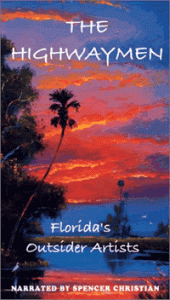The Childhood of the Highwaymen
Listen to the Recess! Clip
| Author | Rita Smith |
| Air Date | 2/18/2002 |

The Childhood of the Highwaymen Transcript
Brief sound clip
That’s the African American artist, James Butler, talking about his early commitment to art on a documentary film by Julia D’Amico called The Highwaymen. Everyone has been talking about the Highwaymen in Florida for the past few years. They’re a group of African American artists, male and female, that included Mr. Butler, who began painting scenes of quintessential Florida in the 1960s — scenes of incandescent sunsets seen through almost limbless pine trees clustered on Florida’s flat savannahs, or palm trees, their fronds leaning with the wind set into the dunes while in the background, the surf has formed itself into lime green lines to lap the long beach.
Several dozen of these artists began painting these pictures some forty years ago, and then sold them for ten or twenty or thirty dollars apiece to the doctors and dentists, lawyers and bankers and motel and restaurant keepers who did business up and down the highways of South Florida during the great post-air-conditioning, Kennedy Space Center, retirement boom that transformed the state. Most of these artists grew up in the Ft. Pierce area, where they were drawn, many as children and teenagers to the studio of Florida’s grandfather of landscape painting, Beanie Bachus, who defied Jim Crow laws and gave lessons to the young artists.
The group was led by a charismatic young painter, Alfred Hair. His gifts were spotted by his high school art teacher, Zenobia Jefferson, who sent him to study with Bachus. Hair saw painting as a liberation for young African Americans, from being consigned to fruit picking and other hard, manual labor. Hair knew he could never make a living on his paintings the same way his established white mentor, Bachus, could. So Hair resolved to work fast and in quantity, painting on inexpensive Upson board, a dozen two by three foot tacked onto the wall of his mother’s house, with friends and neighbors stopping by to watch, then to help, then to become painters themselves. And it happened, this Ft. Pierce Renaissance, because two teachers, one black and one white recognized talent in young people and found ways to help it grow.
SHARE
Share this content on these platforms.